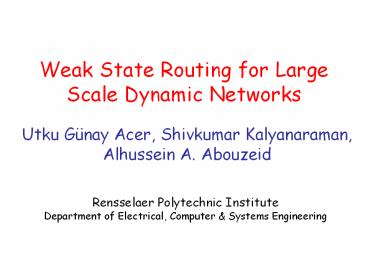Weak State Routing for Large Scale Dynamic Networks - PowerPoint PPT Presentation
Title:
Weak State Routing for Large Scale Dynamic Networks
Description:
Weak State Routing for Large Scale Dynamic Networks Utku G nay Acer, Shivkumar Kalyanaraman, Alhussein A. Abouzeid Rensselaer Polytechnic Institute – PowerPoint PPT presentation
Number of Views:132
Avg rating:3.0/5.0
Title: Weak State Routing for Large Scale Dynamic Networks
1
Weak State Routing for Large Scale Dynamic
Networks
- Utku Günay Acer, Shivkumar Kalyanaraman,
Alhussein A. Abouzeid
Rensselaer Polytechnic Institute Department of
Electrical, Computer Systems Engineering
2
- Which area should we NOT be working on in
MOBICOM anymore? - Ans Routing !
- - Victor Bahl, Mobicom 2007 panel
3
Routing in Large-scale Dynamic Networks
- Routing table entries state indirections
from persistent names (ID) to locators - Due to dynamism, such indirections break
- Problematic on two dimensions
- Dynamism/mobility gt frequent update of state
- Dynamism large scale gt very high overhead,
hard to maintain structure - We propose constructing routing table
indirections using probabilistic and more stable
state WEAK STATE
Node Mobility
Number of Nodes
4
A new class of State
- Strong State
- Deterministic
- Requires control traffic to refresh
- Rapidly invalidated in dynamic environments
- Weak State
- Probabilistic hints
- Updated locally
- Exhibits persistence
5
Hard, Soft and Weak State
a
b
STATE B
STATE B
STATE A
STATE A
Time elapsed since state installed/refreshed
Confidence in state information
Hard State
Soft State
Weak State
Weak State is natural generalization of soft state
6
Random Directional Walks
- Both used to announce location information
(put) and forward packets (get)
7
Outline
- Our Weak State Realization
- Disseminating Information and Forwarding Packets
- Simulation Results
- Discussion Conclusion
8
An Instance of Weak State
SetofIDs
GeoRegion
a,b,c,d,e,f
Probabilistic in terms of scope
Probabilistic in terms of membership
- The uncertainty in the mappings is captured by
locally weakening/decaying the state - Other realizations are possible
- Prophet, EDBF etc
9
Example Weak State
- Consider a node a
- Where is node a?
- (i) It is in region ABwith probability ?1
- (ii) It is in region B with probability ?2(?1
?2)
10
How to Weaken State?
Larger Geo-Region
128.113.
128.113.50.
Aggregation
128.113.62.
SetofIDs -gt GeoRegion
11
Aggregation setofIDs
- setofIDs We use a Bloom filter, denoted by B.
m1
m2
.
.
k
k
.
0
1
0
0
0
0
0
0
1
1
1
1
1
1
u
hj(m1)
hi(m2)
hi(m1) hj(m2)
12
Decaying/Weakening the setofIDs
- Randomly reset 1s to 0. Same as EDBF Kumar et
al. Infocom05 - Let ?(m)?i1m B(hi(m))
- Large ?(m) ! fresh mapping
- ?(m)/k is a rough measure of Pxm 2 A
13
Weakening State (Contd)
setofIDs small, time passes Decay GeoRegion
Either setofIDs large OR GeoRegion Large
gt Decay SetofIDs
14
Random Directional Walks
- Both used to announce location information
(put) and forward packets (get)
15
Dissemination/Proactive Phase (put)
- When a node receives a location announcement, it
- creates a ID-to-location mapping
- aggregates this mapping with previously created
mappings if possible
C
B
A
16
Forwarding Packets(get)
A
S
B
C
WSR involves unstructured, flat, but scalable
routing no flooding !
E
D
Forwarding decision similar to
longest-prefix-match. strongest semantics
match to decide how to bias the random walk.
17
Simulation Objectives
- How does WSR perform?
- Large-scale
- High Mobility
- Comparisons
- DSR works well for small scale, high mobility
- GLSGPSR works well for large scale, low
mobility - Short answer 98 packet delivery despite large
scale AND high mobility. - Tradeoffs longer path lengths, ?(N3/2) state
overhead
18
Simulation Setup
- Benchmarks
- DSR and GLS-GPSR
- Random waypoint mobility model with vmin5 m/s
and vmax10 m/s - WSR is robust against dynamism (please see the
paper for details) - Performance Metrics
- Packet delivery ratio
- Control packet overhead
- Number of states maintained
- Normalized path length
- End-to-end Delay
19
Packet Delivery Ratio
- GLS breaks down due to overheads
DSR only delivers a small fraction of packets
WSR achieves high delivery ratio
20
Control Packet Overhead
- Maintaining structure requires superlinearly
increasing overhead in GLS
21
Number of States Maintained
The total state stored in the network increases
as ?(N3/2) instead of ?(NlogN)
22
Per-Node State Dynamics
State generation rate matches state removal rate.
23
Distribution of Per-Node State in the Network
- The states are well distributed with a C.o.V
0.101
24
Normalized Path Length
Packets take longer paths with WSR
- GLS sends packets only to destinations that are
successfully located
25
But, E2E Delay is Lower!
WSR uses random walks for discovery
dissemination gt end-to-end delay is smaller
26
Discussion/Future Work
- Weak State Routing also relates to
- DTN routing
- Unstructured rare object recall in P2P networks
- Distributed Hashing
- Future work
- Such extensions (especially DTNs)
- Theoretical analysis
27
Conclusion
- Weak state is soft, updated locally,
probabilistic and captures uncertainty - Random directional walks both for location
advertisement and data forwarding. - WSR provides scalable routing in large, dynamic
MANETs - WSR achieves high delivery ratio with scalable
overhead at the cost of increased path length
28
Thank you
- Questions?































